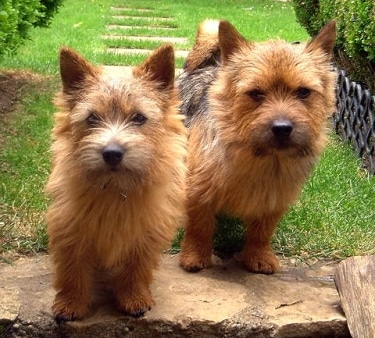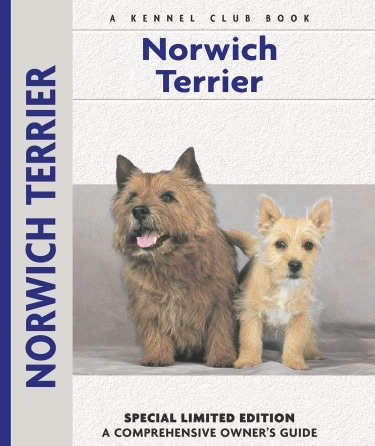
The Norwich Terrier is a feisty and fearless sturdy dog measuring no more than ten inches at withers. He is lovable, friendly, good natured and thrives on human companionship. The Norwich Terrier comes from the East Anglia region in England where he was used primarily as a ratter as well as to hunt other small vermin. (Norwich is the nominal capital of this region.)
Norwich Terriers were also later used to bolt foxes during a hunt. This particular type of dog has been around since at least the late 1800s and it is believed possible ancestors might include the Irish Terrier, Trumpington Terrier, red terrier and other terrier breeds.
The Norwich Terrier had two varieties and the most distinguishing feature which divided them was the ear carriage. In 1964, England recognized the two as separate breeds – the Norwich Terrier has the prick ear while the ‘new’ Norfolk Terrier has the drop ear. The American Kennel Club officially recognized the Norwich Terrier in 1936, but not until 1979 did it divide the two varieties and recognize the Norfolk Terrier as separate breed.
Height: The ideal height for a Norwich Terrier “…should not exceed 10 inches at the withers” according to the AKC breed standard. (10 inches = 25.4 centimeters)
Weight: The weight for the Norwich Terrier should be approximately 12 pounds (5.44 kilograms). Weight should be proportion to the size of the Norwich Terrier.
Coat Type: The Norwich Terrier has a double coat. The outer coat is lies close to the body and is wiry, hard and straight. The Norwich Terrier’s undercoat is soft. Medium in length and shaggy and is more pronounced around the neck and shoulder forming a mane. Grooming is minimal – the coat should never be clipped, just tidied so that it appears as natural as possible. Basic maintenance for the Norwich Terrier coat includes brushing daily or weekly with a steel comb. The Norwich Terrier is a light shedder.
Color: The color of the Norwich Terrier coat varies and can be any shade of wheaten, red, black and tan or grizzle (gray or grayish).
Temperament: The Norwich Terrier is active, affectionate and very intelligent. He is rarely aggressive and generally does well with other pets as long as they have been socialized with them. Norwich Terriers are good natured and love people – including children – and do not shy away from strangers. However, he will bark at those he does not know making him a good watch dog. He is sensitive and responds best to positive training methods. Norwich Terriers want to be with people and not left outside for long periods where they can quickly become bored and start digging and / or barking. This breed as with any terrier can be stubborn, independent and dominant, therefore it’s extremely important for any owner to understand he must always be seen as the leader. Daily walks and free play with your Norwich Terrier are perfect for exercise and stimuation.
Health Concerns: The Norwich Terrier is a generally a very healthy breed. Some health issues which can occur include: epilepsy, cataracts, hip dysplasia, mitral valve disease and narrow tracheas which can cause breathing problems. However, none of these health issues are prevalent among the Norwich Terrier breed. Life expectancy for a Norwich Terrier is between 12 – 16 years.
Special Interest:
• The American Kennel Club officially recognized the Norwich Terrier in 1936.
• Norwich Terriers with drop ears became known as Norfolk Terriers and were recognized by the AKC as a separate breed in 1979. Norwich Terriers have prick ears.
• In the 1880s, it was trendy for Cambridge University students to own a Norwich Terrier which they referred to as Cantab Terrier.
Classifications:
AKC: Terrier Group
ANKC: Group 2 Terriers
CKC: Group 4 Terriers
FCI: Group 3 Section 2 Small Sized Terriers
KC: Terriers
NZKC: Terriers
UKC: Terriers
 Kennel.com – Complete Guide to Dogs The Dog Lovers Guide
Kennel.com – Complete Guide to Dogs The Dog Lovers Guide
 Norwich Terrier – Limited Edition
Norwich Terrier – Limited Edition